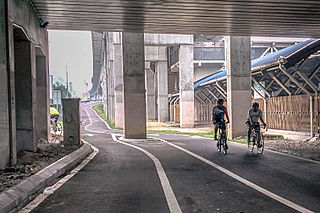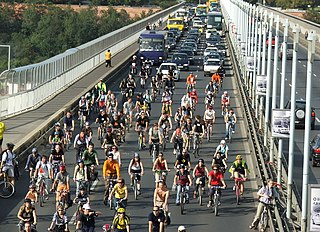
A bicycle, also called a pedal cycle, bike, push-bike or cycle, is a human-powered or motor-assisted, pedal-driven, single-track vehicle, with two wheels attached to a frame, one behind the other. A bicycle rider is called a cyclist, or bicyclist.

Cycling, also known as bicycling or biking, is the activity of riding a bicycle or other type of cycle. It encompasses the use of human-powered vehicles such as balance bikes, unicycles, tricycles, and quadricycles. Cycling is practised around the world for purposes including transport, recreation, exercise, and competitive sport.

Utility cycling encompasses any cycling done simply as a means of transport rather than as a sport or leisure activity. It is the original and most common type of cycling in the world. Cycling mobility is one of the various types of private transport and a major part of individual mobility.

Bicycle commuting is the use of a bicycle to travel from home to a place of work or study — in contrast to the use of a bicycle for sport, recreation or touring.
In transport engineering nomenclature, a counterflow lane or contraflow lane is a lane in which traffic flows in the opposite direction of the surrounding lanes.

Cycling is the second-most common mode of transport in the Netherlands, with 36% of Dutch people listing the bicycle as their most frequent way of getting around on a typical day, as opposed to the car (45%) and public transport (11%). Cycling has a modal share of 27% of all trips nationwide. In cities this is even higher, such as Amsterdam which has 38%, and Zwolle 46%. This high frequency of bicycle travel is enabled by excellent cycling infrastructure such as cycle paths, cycle tracks, protected intersections, ample bicycle parking and by making cycling routes shorter and more direct than car routes.

Cycling is a popular mode of transport and leisure activity within London, the capital city of the United Kingdom. Following a national decline in the 1960s of levels of utility cycling, cycling as a mode of everyday transport within London began a slow regrowth in the 1970s. This continued until the beginning of the 21st century, when levels began to increase significantly—during the period from 2000 to 2012, the number of daily journeys made by bicycle in Greater London doubled to 580,000. The growth in cycling can partly be attributed to the launch in 2010 by Transport for London (TfL) of a cycle hire system throughout the city's centre. By 2013, the scheme was attracting a monthly ridership of approximately 500,000, peaking at a million rides in July of that year. Health impact analyses have shown that London would benefit more from increased cycling and cycling infrastructure than other European cities.

Cycling in Sydney, New South Wales, Australia takes place for recreation, commuting and as a sport. Sydney has a hilly topography and so may require a slightly higher level of fitness from cyclists than flatter cities such as Melbourne and Canberra. Sydney depends heavily on motor vehicles where traffic and public transport operate at capacity. This means that cyclist are often competing with motorists for limited space on busier roads, and for limited government resources for expenditure on road infrastructure. In its favour, Sydney has a generally mild climate and there are active cycling groups.

Cycling in New York City is associated with mixed cycling conditions that include dense urban proximities, relatively flat terrain, congested roadways with stop-and-go traffic, and streets with heavy pedestrian activity. The city's large cycling population includes utility cyclists, such as delivery and messenger services; cycling clubs for recreational cyclists; and increasingly commuters. Cycling is increasingly popular in New York City; in 2018 there were approximately 510,000 daily bike trips, compared with 170,000 daily bike trips in 2005.

Cycling in New Zealand is the 5th most popular form of active recreation, but a very marginal commuting mode, with the share hovering around 1–3% in most major cities. This is due to a number of factors, principally safety fears.

Cycling in Copenhagen is – as with most cycling in Denmark – an important mode of transportation and a dominating feature of the cityscape, often noticed by visitors. The city offers a variety of favourable cycling conditions — dense urban proximities, short distances and flat terrain — along with an extensive and well-designed system of cycle tracks. This has earned it a reputation as one of the most bicycle-friendly cities in the world. Every day 1.2 million kilometres are cycled in Copenhagen, with 62% of all citizens commuting to work, school, or university by bicycle; in fact, almost as many people commute by bicycle in greater Copenhagen as do those cycle to work in the entire United States. Cycling is generally perceived as a healthier, more environmentally friendly, cheaper, and often quicker way to get around town than by using an automobile.

Cycling in Canada is experienced in various ways across a geographically huge, economically and socially diverse country. Among the reasons for cycling in Canada are for practical reasons such as commuting to work or school, for sports such as road racing, BMX, mountain bike racing, freestyle BMX, as well as for pure recreation. The amount and quality of bicycle infrastructure varies widely across the country as do the laws pertaining to cyclists such as bicycle helmet laws which can differ by province.

Cycling in Denmark is both a common and popular recreational and utilitarian activity. Bicycling infrastructure is a dominant feature of both city and countryside infrastructure with segregated dedicated bicycle paths and lanes in many places and the network of 11 Danish National Cycle Routes extends more than 12,000 kilometres (7,500 mi) nationwide. Often bicycling and bicycle culture in Denmark is compared to the Netherlands as a bicycle-nation.

Cycling in Atlanta has grown in popularity in recent years, from 0.33% of commutes in 2000 to 1.1% in 2009, aided by improving cycling infrastructure and community support. Although Atlanta has historically been a city defined by the automobile, its increasingly compact urban form and mild climate are encouraging residents to cycle to work, shopping, and recreational destinations. Though Atlanta's famed hilly topography can make cycling challenging, though fun, many parts of the city are relatively flat, including some of the more densely populated areas. However, heavy automobile traffic, the lack of bike lanes on many streets, and difficulty in crossing major streets deter most residents from cycling frequently in Atlanta.

Cycling infrastructure is all infrastructure cyclists are allowed to use. Bikeways include bike paths, bike lanes, cycle tracks, rail trails and, where permitted, sidewalks. Roads used by motorists are also cycling infrastructure, except where cyclists are barred such as many freeways/motorways. It includes amenities such as bike racks for parking, shelters, service centers and specialized traffic signs and signals. The more cycling infrastructure, the more people get about by bicycle.

Cycling in Kuala Lumpur refers to the bicycle uses in Kuala Lumpur, Malaysia for touring, recreational, work and transportation purpose. It was first appeared on 1938 when there is a first road cycling race that has been introduced in Kuala Lumpur. The introduction of the bicycle in Kuala Lumpur was later become one of the preferred transportation methods for students and mid-class citizens. As Kuala Lumpur begin its rapid urbanization progress since 1960s, the usage of bicycle start to decline as people shifting their transportation method to driving. In recent years however, the roads of the city have seen an increased presence of cyclists, whereas the importance of doing exercise has become more recognized. To match this positive change, and to reduce air pollution, the city urgently needs the introduction of more pavements and bicycle lanes, ideally by leveraging on the vast area that is currently taken up by motorways. Given that Kuala Lumpur lacks many bicycle-friendly routes suitable for cyclists in the city, however, proposals of a bicycle infrastructure of urban bicycling program were drafted, mainly under the Kuala Lumpur Structure Plan 2020 and cycling activism by Cycling Kuala Lumpur in order to encourage more citizens of Kuala Lumpur to cycle in the urban area.

Cycling in the United Kingdom has a long history, since the earliest days of the bicycle, and after a decline in the mid-20th century has been undergoing a resurgence in recent decades.

Cycling in Penang Island refers to the use of bicycles in the city of George Town and elsewhere on Penang Island, Malaysia, either for recreational, touring or transportation purposes. While bicycles have long been in use in Penang, with rickshaws becoming a unique application of the pedal-driven vehicle in the state, the usage of bicycles has noticeably declined since the late 20th century due to the proliferation of cars as the main transportation mode.

Cycling in Prague is a popular leisure activity and a not so common mode of transport within the capital city of the Czech Republic. However, levels of utility cyclists have been rising recently. In 2018, 2% of people commuted by bike in Prague. As of 2017, there were 178 km (111 mi) of protected cycle paths and routes in the city. Also, there are 48 km (30 mi) of bike lanes and 24 km (15 mi) of specially marked bus lanes that can be used by cyclists.

Cycling in Canberra, the capital city of Australia, is a popular means of transportation, sporting and recreational pass time. Commuting in the city is supported by an extensive network of urban cycleways and on-street bicycle lanes. As a city established in the 20th century, Canberra's development was heavily influenced by the automobile for much of its history. The popularity of cycling in the city has increased dramatically in the 21st century with growing awareness of environmental issues, government policy supporting active transport and investment in cycling infrastructure. This has led to the development of a strong cycling culture.



















